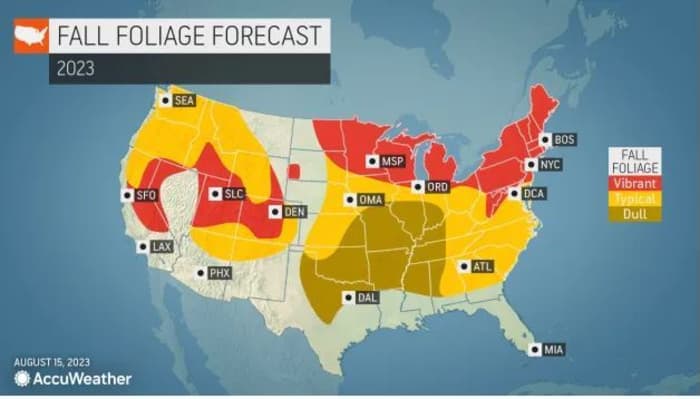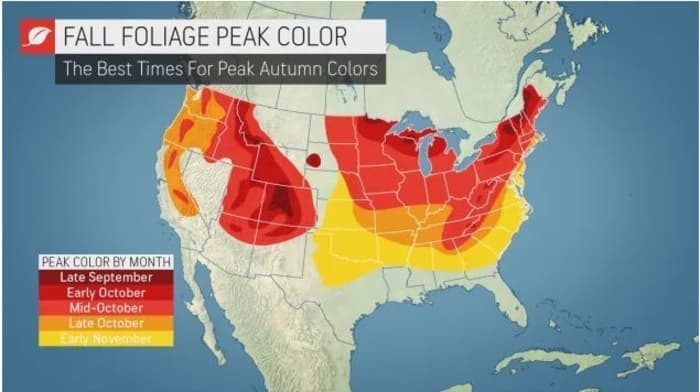This post was originally published on this site
The hottest summer on record for parts of the U.S. stretched into the late days of August and early September, which will have an impact on the vibrancy and timing of this fall’s leaf colors.
In actuality, weather throughout the year plays a significant role in how bright or dull fall foliage will appear, and which regions will have a colorful season, including those like New England, the Upper Midwest, Appalachia and the Rocky Mountain states that bank on leaf-peeping tourist dollars.
For sure, fall excursions to view the color changes should be pushed ahead to the earliest weeks of autumn in key regions known for their showy fall displays, says AccuWeather.
How do spring and summer weather impact fall color change?
Wet weather from late spring through the middle of summer is the first step toward securing a brilliant offering of fall foliage, said Paul Pastelok, AccuWeather’s senior meteorologist.
On the contrary, drought and intense, long-lasting heat can lead to dull colors, as the conditions put trees under more stress and likely cause them to shed their leaves early, before the normal process of gradually losing chlorophyll has a chance to accelerate before leaves release from tree branches.
Late summer conditions aren’t exactly playing fair. Heat and dryness dominated large parts of the U.S. as kids returned to school in recent weeks.
Drought conditions worsened in the Northwest, Plains, Midwest and from eastern Arizona across to Louisiana and Mississippi. Nationwide drought conditions rose for the 8th straight week as of Sept. 5, government data shows, with 36% of the lower 48 states considered to be in drought, according to the U.S. Drought Monitor.
In fact, the heat this summer for many parts of the country rewrote the record books. A recent report issued by the U.N.’s World Meteorological Organization declared summer 2023 the hottest on record as persistent global warming from burning fossil fuels like coal and oil
CL00,
along with the shorter-term heat impact from an early showing of an El Niño, drove the thermometer higher from Texas to New York to Spain to China.
Read: It’s official: This summer was the hottest on record
And: July 2023 is the hottest month ever recorded. Blame global warming and El Niño.
For the globe, August averaged about 1.5 degrees Celsius (2.7 degrees Fahrenheit) warmer than pre-industrial averages. That translated to a record string of days above 90 degrees F for Phoenix, and hot and humid conditions above 100 degrees F over an uncomfortable run of days in areas of Texas. There were a couple of extreme-heat spells in the U.S. Northeast, too, including in recent days and nights during the U.S. Open tennis Grand Slam.
Read: Climate protest interrupts U.S. Open semifinal eventually won by Coco Gauff
Elsewhere, parts of Nevada, Colorado and New Mexico tied their all-time temperature highs this summer, while portions of Arizona marked their highest-ever night-time temperatures.
In the weeks before their transformation, trees prefer warmish, sunny days and crisp, cool nights to bring on the most vibrant color transformation.
For sure, a mild fall that brings some cooling relief will be embraced by much of the country’s trees and its people. But if it gets too cold, too fast, leaf-viewing time will be crimped. An early frost can lead to brittleness for already thirsty leaves and impact how long those leaves can hang on branches before gravity pulls them to the ground.
Where’s the best place to see brilliant fall foliage this year?
“The best places to check out the fall foliage this season is probably going to be across the Northeast, the Great Lakes, and then even the West,” AccuWeather’s Pastelok said.
This includes popular leaf-peeping destinations such as New England, the Upper Midwest and the aspen groves in Colorado and Utah.
“The aspens should come out looking really good in late September to mid-October,” Pastelok added. Some colors are expected elsewhere across the Rocky Mountains, the Cascade Mountains and most of the Appalachians, but there is one larger zone where Pastelok said colors may not be quite as vivid.
Long-duration hot spells over the southern U.S. have put quite a bit of stress on trees from Texas to Alabama and northward into Illinois and Indiana. Severe weather events during the first half of fall could blow leaves off of the stressed trees around the same time as peak season.

The U.S.’s mid-section, down into Texas, could see much duller fall foliage than in other years after the extreme heat of summer.
Accuweather
“On top of that, we could see a big change in October where some cold air can come down causing an early frost,” Pastelok added. As a result, Pastelok said, colors in about a dozen states could be dull compared to other regions of the country.
Jim Salge, a former meteorologist at New Hampshire’s Mount Washington Observatory, suggested that extreme flooding earlier this year in Vermont could lead to disappointment for fall leaves. Salge has written a New England foliage forecast for Yankee Magazine for more than 20 years.
Related: What exactly are flash floods, like those hitting New York and Vermont this week?
Salge’s latest report revealed his concerns. For one, the summer’s heavy rains could have waterlogged the trees’ roots and interfered with respiration, the process of converting sugars into energy. That means leaves could change earlier than usual.
And the change itself could be lackluster. Long stretches of warm temperatures could dilute the colors, meaning the fiery reds of maples will instead be a duller pinkish red.
Excess water could also have brought an infestation of fungus that can tone down the hues, he wrote.
When is the best time to see peak leaf color change?
The best time to see mountainsides transform into breathtaking displays of yellow, orange and red varies from region to region, starting early in the season across the northern tier and across the Rocky Mountains, and later in autumn for areas farther south, according to AccuWeather.

New England, especially, could see early leaf color changes this year after extreme rain and flooding.
AccuWeather
In 2023, AccuWeather predicts that the best time to see fall foliage in New England, the Upper Midwest and the Rocky Mountains will be in late September and early October.
By mid-October, peak colors are expected across the majority of the Northeast, the Appalachian Mountains, the Ohio Valley and across the Midwest.
For areas from the central U.S. to the Gulf Coast and part of the coastal mid-Atlantic, the most brilliant colors are not expected until later in October and during the first weeks of November.
However, for part of this zone, even when the change does come, the displays are not expected to rival those in other areas of the country.
And in the West?
The pinnacle of picturesque foliage is predicted to occur during the second half of October for most of Washington, Oregon and California, says AccuWeather.

